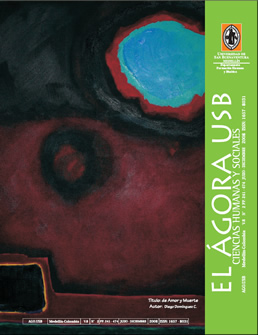View/Download
How to Cite
Peláez Toro, E., Muñoz Cuartas, M., Insuasty Rodríguez, A., & Aristizabal, W. (2008). Psychosocial characterization of neighborhood youth July 20 Township urrao, southwestern Antioquia. Ágora USB, 8(2), 417–435. https://doi.org/10.21500/16578031.1538
More Citation Formats
License terms
▼
The authors are also adhere to the creative commons license 4.0 (https://creativecommons.org/licenses/by-nc-nd/4.0/deed.es)
Attribution - NonCommercial - SinDerivar 4.0 International (CC BY - NC - ND 4.0)
Abstract
One of the goals proposed in the Development Plan 2008 - 2011 "Antioquia for all hands on deck" 4 is to link the population in the collective construction of security and create conditions for coexistence and peace. In this sense the Peace Advisory Board of the Government today streamlines activities which promote the achievement of this aim, and with support from the University of San Buenaventura de Medellin, in the municipality of Urrao an investigation to characterize one was performed neighborhoods affected by the "violence and at risk of causing violence." This article is presented as a preview of the results of that investigation, which was conducted as a retrospective study in the July 20 Barrio Township Antioquia Urrao. The study involved families and young people from the neighborhood, plus five institutions that provide direct care to the community. The purpose of the study was to characterize the population of the district in order to identify current factors affecting the living, but for purposes of this paper provides the results found with young people be released. The results described in the juvenile characterization are grouped into: education levels of the population, labor level, characteristics of the families of young people, sexual and reproductive health, alcohol and psychoactive, social spaces, use of leisure time, expulsion and movement of young people. Finally, some conclusions and recommendations are presented for intervention
Keywords:
Downloads
Download data is not yet available.




















